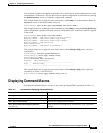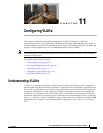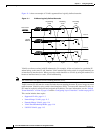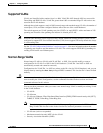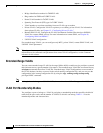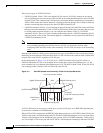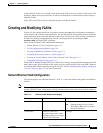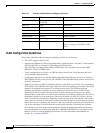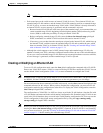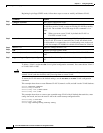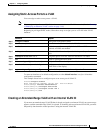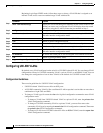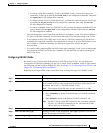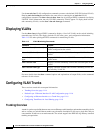
11-7
Cisco ME 3400 Ethernet Access Switch Software Configuration Guide
OL-9639-06
Chapter 11 Configuring VLANs
Creating and Modifying VLANs
isolated VLAN. In this case, isolation occurs between the UNI access port and the VLAN on the UNI
trunk port. Other access ports and other VLANs on the trunk port are isolated because they belong to
different VLANs.
UNIs, ENIs, and NNIs are always isolated from ports on different VLANs.
Creating and Modifying VLANs
You use VLAN configuration mode, accessed by entering the vlan global configuration command to
create VLANs and to modify some parameters. You use the interface configuration mode to define the
port membership mode and to add and remove ports from VLANs. The results of these commands are
written to the running-configuration file, and you can display the file by entering the show
running-config privileged EXEC command.
These sections contain VLAN configuration information:
• Default Ethernet VLAN Configuration, page 11-7
• VLAN Configuration Guidelines, page 11-8
• Creating or Modifying an Ethernet VLAN, page 11-9
• Assigning Static-Access Ports to a VLAN, page 11-11
• Creating an Extended-Range VLAN with an Internal VLAN ID, page 11-11
• Configuring UNI-ENI VLANs, page 11-12
If the switch is running the metro IP access or metro access image, for more efficient management of the
MAC address table space available on the switch, you can control which VLANs learn MAC addresses
by disabling MAC address learning on specific VLANs. See the
“Disabling MAC Address Learning on
a VLAN” section on page 5-27 for more information.
Default Ethernet VLAN Configuration
The switch supports only Ethernet interfaces. Table 11-2 shows the default configuration for Ethernet
VLANs.
Note On extended-range VLANs, you can change only the MTU size, the private VLAN, the remote SPAN,
and the UNI-ENI VLAN configuration. All other characteristics must remain at the default conditions.
Ta ble 11-2 Ethernet VLAN Defaults and Ranges
Parameter Default Range
VLAN ID 1 1 to 4094.
Note Extended-range VLANs (VLAN
IDs 1006 to 4094) are not saved in
the VLAN database.
VLAN name VLANxxxx, where xxxx
represents four numeric digits
(including leading zeros) equal
to the VLAN ID number
No range



